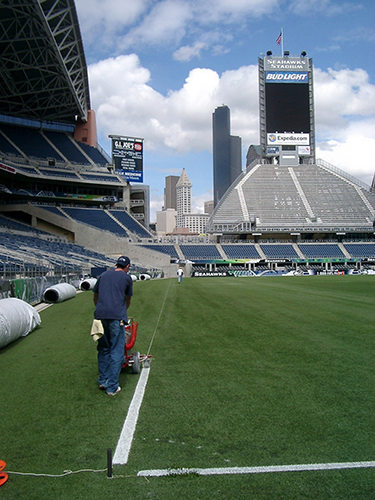|
Subscribe / Renew |
|
|
Contact Us |
|
| ► Subscribe to our Free Weekly Newsletter | |
| home | Welcome, sign in or click here to subscribe. | login |
Environment
| |
 |
September 25, 2014
Survey: Eco Chemical
Specialty: Environmentally friendly paints and coatings
Management: Mark Cheirrett, founder and president; Peg Cheirrett, vice president of finance
Founded: 1991
Headquarters: 22,000-square-foot facility in Seattle’s Georgetown neighborhood
2013 revenues: $2.6 million
Projected 2014 revenues: $3.1 million
The DJC asked Peg Cheirrett, vice president of finance, about Eco Chemical. Here is what she said:
Q: How did your company get its start?
A: Mark Cheirrett, our CEO, had worked in the chemicals and coatings industry for a number of years. He felt there was a desperate need for less environmentally damaging products. For example, when he was manufacturing moisture-cured urethanes, he noticed employee skin rash problems stemming from exposure to the toxic ingredients.
Eco Chemical water-based products eliminate the need for these ingredients along with the volatile organic compounds that create smog and toxic emissions.
Q: What segments of your market are doing well?
A: Our fastest growing product is our line of athletic field paints and removers. We were the first to produce paint for synthetic fields that could be applied and easily removed. Mark invented this product, working with the Seattle Seahawks in 2003. All of our products in this market are water-based and environmentally friendly. Since many synthetic fields are multi-use, it’s helpful to be able to quickly and easily remove paint lines and repaint for the next event.
We also invented equipment designed to facilitate paint removal. Our Mantis hydro extractor is the top of the line and the favorite of both the NFL and CFL. It’s the artificial grass equivalent of a Zamboni — pressure washing, scrubbing and vacuuming the field in one pass.
Q: What differentiates your products?
A: Being water based is an added advantage, besides providing high-quality colors and brightness, being able to stand up to weather as well as player wear and tear, yet still be easily removed when necessary.
Q: Is it used just on the West Coast?
A: Our initial market strength has been in the West but our revamped marketing program has created substantial growth for us this year in the East. In fact, if you watched the recent Monday Night Football game in Indianapolis, our product was used on that field. We have quite a few National Football League pro teams as our customers.
Q: Is it also used on grass fields?
A: We actually created a special product for grass fields. Grass paints aren’t typically removed but need to be harmless to natural grass and soil. In 2010 we developed a concentrated water-based product consisting of separate powder and paste components that are shipped in a recyclable cardboard box. The customer adds water at their location, saving on the need for storage space and lowering the cost of shipping.
Most of our grass paint sales are to colleges and municipal parks departments around the country, including Seattle Parks & Recreation.
Q: What other segments of the industry are you involved in?
A: Our largest segment of the market is wood stains for pressure-treated lumber. These products are typically packaged in 275-gallon recyclable totes and sold to mills and pressure-treating plants, primarily in the West. Recent rebounds in the housing industry and the continuing trend towards stained pressure-treated products have contributed to excellent growth for us in this segment for the last couple of years.
Q: Do you sell products to retail outlets like Home Depot?
A: We presently only sell to lumber products manufacturers who in turn, typically sell their stained products to building material retailers such as Home Depot and Lowe’s. We offer a broad spectrum of colors to our customers although the majority of our sales are various shades of red or brown.
Q: What measures do you take at your facilities to be eco-friendly?
A: We practice waste and pollution reduction throughout our manufacturing, packaging and shipping processes. For example, we manufacture only water-based paints and stains, so we emit no toxic fumes or discharge any hazardous substances; we capture the wastewater used to clean our mixing tanks and use it in the next batch; and we filter out solids from our waste stream and send a concentrated sludge to a solid waste facility rather than down the sewer.
We order our resins in 275-gallon plastic totes and then reuse those totes to ship our concentrated stains to our customers — resulting in one of the largest tote recycling programs on the West Coast.
Other Stories:
- Passive House finds a permanent home in the Northwest
- Survey: Landau Associates
- Survey: HWA GeoSciences
- Survey: Environmental Resources Management
- Survey: WISErg Corp.
- Survey: Environmental Sciences Associates
- Survey: Farallon Consulting
- These modular classrooms are not old school
- Local firms invent modules to protect Louisiana coast
- Old mining pond becomes new salmon habitat
- Time to jump on contaminated urban properties?
- Tackling toxics with green chemistry
- How biosolids can curb greenhouse gases
- Lower Duwamish: watershed management poster child?
- Is hard water drowning Eastern Washington’s economy?
- Preserving Seattle’s largest forest takes a group effort
- Being green is not just about checking boxes
- Carbon-rich tidal wetlands down, but not out
- Survey: Herrera Environmental Consultants



